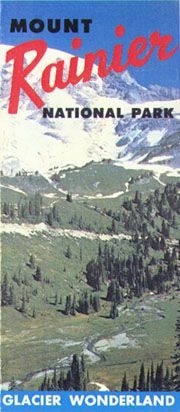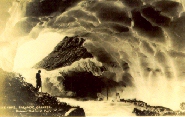 “Our lives forever demand and need visual images that can be symbols to us of the grandeur or the sweetness of repose….And, studying the light and majesty of Tacoma, there passed from it and entered into my being,…a thought and an image of solemn beauty, which I could thenceforth evoke whenever in the world I must have peace or die.” –Theodore Winthrop, The Canoe and Saddle, 1862
“Our lives forever demand and need visual images that can be symbols to us of the grandeur or the sweetness of repose….And, studying the light and majesty of Tacoma, there passed from it and entered into my being,…a thought and an image of solemn beauty, which I could thenceforth evoke whenever in the world I must have peace or die.” –Theodore Winthrop, The Canoe and Saddle, 1862

Although not a part of a national park movement, Winthrop’s thoughts illustrate a growing awareness of the grandeurs of Mount Rainier and a desire to see the area protected from desecration. Throughtout the late nineteenth century, many more people explored the areas around mountain, documenting its unique features and appeal. In March of 1899, the federal government granted Mount Rainier protection as a national park. Status as a national park mandated preservation of natural resources and access for enjoyment by the public, the desire of the countless local and national figures, who lobbied for Mount Rainier’s park status.

“Even before the establishment of Mount Rainier National Park, citizens of Seattle and Tacoma laid claim to the mountain as a symbol of the good life in the Pacific Northwest. The beauty of Puget Sound’s forests, lakes, tidewater, and mountains was a source of civic pride, and the image of Mount Rainier looming on the horizon beyond Seattle’s Lake Washington or Tacoma’s Commencement Bay was the most commonly used symbol of that pride.” –Theodore Catton, Wonderland: an administrative history of Mount Rainier National Park, 1996, p. 35

In the 100 years since the park’s establishment, the mountain’s beauty continues to be celebrated and the park is known for its subalpine meadows, lakes, summit climbs and trail system, in addition to the volcano itself. Visitors use the park year round, placing demands on facilities in a variety of ways. Annual visitation has reached into the millions, up from the 2,000 people who visited in 1899. And, throughout the park’s history, different park administrations and interests have introduced evolving services and development projects, demonstrating shifting conservation priorities.
Fun Facts About Mount Rainier: (from Bette Filley’s The Big Fact Book about Mt. Rainier. Issaquah, WA: Dunamis House, 1996.
- Mount Rainier is the fifth highest peak in the continental United States, at 14,410 feet tall (according to USGS measurement
- It is the largest and highest volcano in the Cascade Range
- Mount Rainier has the fastest-moving glacier in the United States – the Nisqually moves 16 inches per day in the summer!